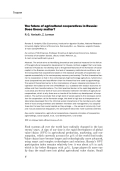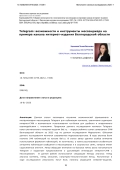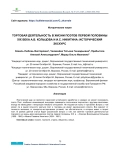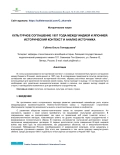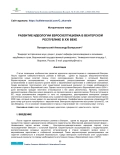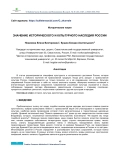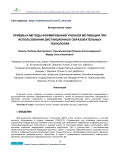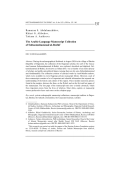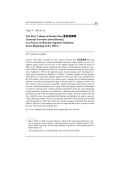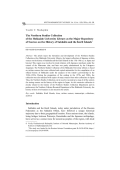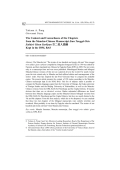The article aims at identifying theoretical and practical reasons for the failure of the agricultural cooperation development in Russia. Authors suggest that rural cooperatives in Russia do not develop due to the general features of the formation of social capital in the Russian countryside, the lack of necessary institutional conditions, and the wrong idea that cooperatives based on the classical principles of cooperation can operate successfully in the contemporary economy and society. The first theoretical barrier to cooperation is that in the contemporary high-technology agriculture, hybrid structures (cooperatives) are less efficient than the hierarchical one used by agroholdings. The second theoretical barrier is the inconsistency of seven classical principles of cooperation formulated at the time of Raiffeisen (i. e. outdated) with today’s economic realities and their transformations. The third practical barrier is the rapid degradation of rural areas and the low level of trust and interaction between members of agricultural cooperatives, which is why there are no trends of the bottom-up development of cooperation. The authors conclude that a high level of social capital is the necessary condition for cooperation: at the formation stage, this level is high due to interpersonal relationships developed from the informal social interactions of its members and a high level of trust among members and between members and management, but cooperatives start to lose their social capital as they enlarge - the sense of community, trust and mutual assistance disappears, the atmosphere becomes more business-oriented.
Данная статья посвящена изучению возможностей функционала и инструментария мессенджера Telegram для публикации контента, увеличения аудитории интернет-СМИ и возможности использования чат-ботов для удобного и оперативного взаимодействия с читателями. Предметом данного исследования является Telegram канал регионального интернет-издания Bel. ru. - лидера рейтинга самых цитируемых СМИ Белгородской области за 2023 год по данным исследования Медиалогии. Объектом данного исследования является современное медиапространство. В ходе анализа были изучены 549 публикаций на канале Bel. ru. В статье автор уделяет особое внимание используемым форматам публикаций, их количеству, а также рассматривает особенности алгоритма публикации сообщения в мессенджерах и в социальных сетях, которые имеют существенные отличия. Автор обращает внимание на быстрые темпы роста популярности Telegram и выдвигает предположение о дальнейшей интеграции интернет-СМИ с мессенджером. В данной работе используются следующие методы анализа: метод анализа контента, метод описания, структурно-типологический метод. Полученные в ходе исследования результаты могут быть полезны редакциям интернет-изданий, планирующим создание канала в мессенджере Telegram или уже имеющим такой канал. Проведенный анализ позволяет сделать вывод о том, что современное интернет-издание использует множество доступных инструментов для создания разнообразного контента, взаимодействия с аудиторией и увеличения ее охвата. В свою очередь, мессенджер Telegram отвечает требованиям интернет-изданий, в частности, предлагая широкий выбор форматов публикаций и возможностью настройки чат-ботов. Автор исследования приходит к выводу, что редакции интернет-изданий, стремящиеся расширить свою аудиторию, могут использовать возможности мессенджера для увеличения присутствия в информационном пространстве, а также увеличения охватов публикаций и дополнительной монетизации.
A poetic gift is not a guarantee of a steady income and often cannot feed a poet. A poet, especially a beginner, has to combine poetic creativity with other occupations, sometimes having nothing to do with literature. Poets are not neglected and trade. The question of whether a poet and a merchant can coexist in one person does not have an unequivocal answer. Everything depends on the personality of the person, on the concrete-historical conditions, on the circumstances in which the poet lives and creates. Within the framework of this article we will consider the question of how the trade activity influenced the life of two Voronezh poets of the first half of the XIX century - Alexei Vasilievich Koltsov (1809 - 1842) and Ivan Savvich Nikitin (1824 - 1861).
The article examines the historical context and main provisions of the Cultural Agreement between India and Japan, concluded in 1957. The study attempts to consider the agreement as an independent historical source, an example of Eastern methods of “soft power” used to strengthen the position of one’s country. The author concludes that the agreement was necessary to strengthen foreign policy ties in the region, it provided benefits to each of the parties, and laid the foundation for further cooperation.
This article is about how Euroscepticism has developed in modern Hungary. After the communist regime fell in Hungary, one of the new government’s top foreign policy priorities was to “reunite” Hungary with the rest of Europe. European integration was associated with modernization, the spread of Western values, and the establishment of a high standard of living in the country with European salaries and a stable economy. There was a unique consensus among the Hungarian political elite on the need for the country to join the European Union. However, after Hungary joined the European Union in 2004, the proportion of Hungarian citizens with a negative attitude towards the EU increased sharply. The reasons for the emergence of Euroscepticism in Hungary can be divided into pragmatic and ideological ones. After joining the EU, when economic expectations were not met, the disappointment of Hungarian citizens increased significantly. The 2008 economic crisis, which hit the Hungarian economy hard, also played a key role in the development of Euroscepticism. The EU’s ineffective crisis management provided fertile ground for the growth in popularity of Eurosceptics. Hungarian Eurosceptics oppose the EU because they are convinced that it threatens the country’s independence and pushes it towards “colonial” status.
The article deals with the specificity of Russia’s cultural and historical patrimony, which begins with a deep study of its Orthodox tradition. When we talk about the Orthodox culture of Russia, we mean not only the past, but also its modern state. The culture of modern Russia includes not only museum exhibits, vast book collections, and impressive architectural structures. Modern Russian culture is reflected in the language, observance of traditions, education system, respect for the older generation, priority of family values, patriotism and respect for other cultures and peoples.
Drawing on students’ views, this article examines the impact of educational strategies and techniques used in distance learning on the development of various motivations for learning, including the desire for interaction, professional growth, exploring new areas, achieving success, connecting with others, creative fulfillment, and avoiding failure.
During the archaeographical fieldwork in August 2024 in the village of Bezhta (Republic of Dagestan), the collection of the Dagestani scholar, the naib of the Caucasian Imamate Sultanmuhammad al-Bezhti, was explored, described and digitized. Sultanmuhammad al-Bezhti, also known as Sultan-dibir, was a founder of an entire dynasty of scholars and public and political figures (among them are his sons, Kebedmuhammad and Abdulmazhid). The collection consists of classical works by Arab-Muslim authors, which were available in every Dagestan private manuscript library. However, each of these manuscripts contains a lot of important and valuable information that expands our understanding of the history and culture of this region. These include numerous glosses found in the margins, between the lines, on the flyleaf, and on the first and last pages of the manuscripts. The last page of the manuscript turns into a family chronicle, which fixes important events from the lives of relatives. Most often, copiists or manuscript owners preferred to leave such notes on the colophon page.
This article examines the first volume of Roshia Ibun 魯西亜異聞 [Unusual Narrative about Russia], a unique handwritten manuscript which depicts the story of a Japanese guard, Torizō. He was one of four Japanese guards who spent the winter of 1806 on the Sakhalin island monitoring the situation at Kushunkotan settlement. Lieutenant Nikolai Aleksandrovich Khvostov visited this settlement during his first expedition to Sakhalin in 1806. In his logbook he gave it an interesting name “Lyubopytstvo”, which can be translated into English as “Curiosity”. Curiously enough, this was the place where Khvostov and the four Japanese guards met for the first time. It is considered to be the first military clash between the countries and a turning point of Russian-Japanese relations, since Russia subsequently began to be perceived as a dangerous enemy. The first volume of the source gives especially valuable information about these events. It provides a detailed description of the voyage of the four Japanese captives to Kamchatka on board of a Russian ship, contains important information about the events during the second expedition of Khvostov and Davidov to Sakhalin and the Kuril Islands in 1807 and relates the trip of the four Japanese guards back to Japan. The first volume of Roshia Ibun, which has never been translated into Russian nor published yet, gives us answers to the following questions. Who was the guard Torizō? How did he perceive the meeting with the Russians in 1806? Were there any official messages or demands from Russian officers? How did Torizō manage to get back to Japan and did he have a chance to share his story with anyone else along the way?
The article traces the formation and development of the Northern Studies Collection at the Hokkaido University Library, the largest collection of Japanese written sources on the history of Sakhalin and the Kuril Islands in the 17th–19th cc. in Japan and beyond. This region was involved in trade relations with Japanese merchants under the control of the Matsumae clan, and later was partly administered by the Tokugawa shogunate. The Northern Studies Collection of the Hokkaido University Library is based on written sources that were collected and copied nationwide for the compilation of an official history of Hokkaido under the auspices of the island’s governorship in the 1910s–1930s. During the preparation of the catalog in the 1970s and 1980s, the collection was also enriched with copies of many sources from other collections in Japan. Thus, the Northern Studies Collection can be used to reconstruct a map of all the centers for storing sources on the history of the region in Japan. As this extensive collection is closely related to the history of the Northern Studies Collection Department and its predecessor, the Northern Cultures Research Department of the Hokkaido University, the history of these two branches is also traced in the article.
The Manchu text “The stories of one hundred and twenty old men” Emu tanggû orin sakda-i gisun sarkiyan compiled by Songyûn (Songyun 松筠) in 1790 was edited by Furentai, and then translated into Chinese by Fugiyûn (Fujun 富俊) in 1809. The text exists only in a manuscript form and was never published. Monolingual Manchu and bilingual Manchu-Chinese versions of this text are scattered all over the world. For nearly twenty years the text existed only in Manchu and had suffered edition and rearrangement of the stories’ order. That fact inspired the late Prof. Giovanni Stary to compare the available copies. The present article presents the content of 120 stories according to the ManchuChinese manuscript kept in the IOM, RAS. This list of subjects made it possible to compare the Manchu language copies from the University of Chicago, the Osaka university of Foreign Studies and the Beijing University of Nationalities, as well as the ManchuChinese versions from the IOM, RAS (St. Petersburg) and the Capital Library. It became obvious that there are no identical versions. Rather substantial differences are found between three Manchu language copies and the Manchu-Chinese bilingual versions from the IOM, RAS (St. Petersburg) and the Capital Library, but they are mostly limited to the 7th and 8th chapters. From the first analysis, which has to be deepened, we can conclude that these two last chapters of the bilingual manuscripts were entirely rewritten and reordered. Most probably it was done by Fugiyûn when he translated “The stories of one hundred and twenty old men” from Manchu into Chinese.
The article presents the Tibetan birchbark manuscripts kept in the Serindian collection of the IOM, RAS. The five birchbark manuscripts exhibit common codicological and paleographic characteristics, and the texts within them demonstrate a functional congruence, primarily associated with the rituals of consecration and empowerment. The objective of the conservation efforts was to flatten the birchbark fragments to both identify and preserve the inscribed texts. The fragments were sufficiently moistened in the birch sap as a plasticizer instead of regular water, given that it is a natural substance inherent to birch bark. The birch sap for conservation was hand-harvested from an ecologically pristine area. The soaking process in warm birch sap softened the fragments, and they were also cleansed of surface impurities. Damaged areas of the birchbark fragments were reinforced using Japanese conservation paper. For subsequent use and preservation, the fragments were stored in envelopes made of high-quality Melinex polyester film. Owing to the restoration work, five Tibetan birchbark manuscripts were described and transliterated.
